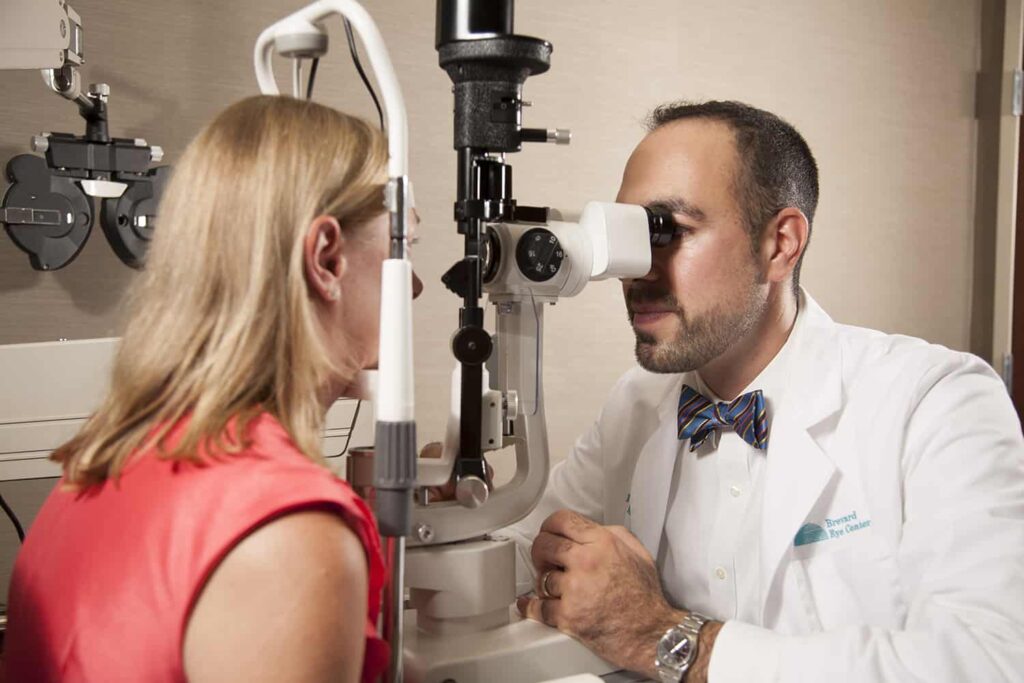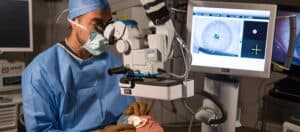Your Guide to Living With Cataracts

Where Are You At In Your Cataract Journey?
Preventing Cataracts | Understanding Cataracts
Treating Cataracts | Managing Cataracts Post-Surgery
If you’ve had a recent eye exam which resulted in a cataract diagnosis or you’re concerned due to family history, you’re probably wondering what you can do to prepare for living with cataracts.
24.4 million Americans who have hit age 40 or higher have cataracts. Double that age and the percentage of people with cataracts in America soars to over 50%. Cataracts are common but that doesn’t mean the problems you face because of them are any less aggravating and life-altering.
We’ve created this guide to help patients pre and post cataract diagnosis with prevention, treatment, and management of this eye condition.
Preventing Cataracts
What Causes Cataracts?
In Short: Cataracts develop from changes in the tissue of your eye lens. This is generally caused by aging, injury, past eye surgeries, or medical conditions.
The Specifics: Cataracts tend to affect older adults, making aging alone a major risk factor. But, there are other factors at play—some preventable, some not.
Cataracts developed from aging generally begin to set it at around age 40. At this point, the proteins in your eye’s lens are beginning to break down. These proteins then clump together and create a cloudy area on the lens of your eye. This cloudy area can then become more severe over time as more of the proteins begin to break down. This is a cataract.
Risk factors for cataracts include:
- Smoking
- Aging
- Obesity
- Previous eye injury
- Previous eye surgery
- Excessive alcohol consumption
- Excessive sun exposure
- High blood pressure
- Family history of cataracts
- Diabetes and other health problems
- Steroid usage, especially for prolonged periods
Watch this video from the National Eye Institute for a better understanding of how the eye works with and without cataracts.
Can Cataracts Be Prevented?
In Short: There are steps you can take to protect your eyes and delay the break down of proteins in your eye lens that will lead to cataract formation.
The Specifics: There are some lifestyle and habit changes you can make to help prevent cataracts from developing.
Habits to adopt or discard for better eye health include:
- Quit smoking
- Protect your eyes with sunglasses
- Eat healthily and stay active
- Get regular dilated eye exams
- Reduce your alcohol consumption
- Manage health problems, like diabetes
While no studies currently exist that prove these methods to be entirely effective at slowing the progression of cataracts, the idea is to reverse engineer the risk factors into preventative measures where possible. For example, you can’t eliminate a family history of cataracts but you can certainly stay healthy and stop smoking.
What Are the Symptoms of Cataracts?
The most easily identified symptom of cataracts is clouded or blurry vision. But this is just one of many symptoms cataracts cause. If you have any of the symptoms below, you should contact your ophthalmologist to schedule a routine eye exam. These symptoms could help catch your cataracts early on or could even point to another eye health concern.
Symptoms of cataracts include:
-
Cloudy Vision
Poor Night Vision
Sensitivity to Light
Halos Around Light
Changing Prescription
Fading Colors
Double Vision
Understanding Cataracts
What Types of Cataracts Are There?
In Short: There are four main types of cataracts: nuclear, cortical, posterior subcapsular, and congenital.
The Specifics: Each type of cataract will affect your eye in a slightly different way and are generally caused by different factors. Understanding each type of cataract will help you to notice specific early warning signs or better understand the type of cataracts you already have.
Cataract Types
Nuclear Cataracts: These are the most common cataracts and are often attributed to old age. Nuclear cataracts get their name from where they develop—right smack in the center of the lens, otherwise known as the nucleus.
These generally cause nearsightedness before causing a dense yellow haze over your vision. Eventually, this yellow will darken to a brown if not treated. This can lead to difficulty in distinguishing colors and picking up finer details. You’re also likely to see halos around lights when you have nuclear cataracts.
Cortical Cataracts: Cataracts that form on the edge of your lens (the cortex) are called a cortical cataract. These generally start as white wedges that grow toward the center of your eyes.
When you develop cortical cataracts your most noticeable symptom will be glare. You’ll also have difficulty driving at night.
Cortical cataracts won’t just attack your near or distant vision—they’ll hurt both. Because of this, those with cortical cataracts tend to be good candidates for early removal.
Posterior Subcapsular Cataracts: These cataracts form behind your lens capsule and block the path of light. They tend to set in quickly and cause symptoms within months, unlike other cataracts which develop much more slowly.
You’ll notice your near vision being affected by posterior subcapsular cataracts, making it difficult for you to do things like reading. It will also be harder for you to see in bright light.
Congenital Cataracts: These cataracts are ones patients are born with or develop during their childhood. Congenital cataracts can be genetic or are caused by problems during the mother’s pregnancy including intrauterine infection, trauma, myotonic dystrophy, neurofibromatosis type 2, rubella, or galactosemia.
These are usually removed after detection in cases where the vision is affected as congenital cataracts that affect vision can actually keep the eye from learning to see if left untreated.
There are other, less common types of cataracts. These are often caused by medical treatments.
These other types of cataracts include:
- Radiation cataracts
- Traumatic cataracts
- Secondary cataracts
- Lamellar cataracts
- Posterior polar cataracts
- Anterior polar cataracts
- Post-vitrectomy cataracts
- Christmas tree cataracts
- Brunescent cataracts
- Diabetic snowflake cataracts
- Posterior capsule opacification cataracts
What Happens If Cataracts Are Left Untreated?
In Short: Leaving cataracts untreated can potentially lead to total blindness.
The Specifics: Untreated cataracts will get worse. This can in turn cause everyday life skills, like driving your car or reading a book, to become impossible. To prevent total blindness, cataracts will need to be treated. The main treatment for cataracts is eye surgery but your ophthalmologist will be the one to ultimately decide the best treatment plan for your eyes.
How Are Cataracts Diagnosed?
In Short: Cataracts are diagnosed during regular dilated eye exams.
The Specifics: During an eye exam your optometrist or ophthalmologist will conduct a visual acuity test, slit-lamp examination, and retinal exam. These are used to determine if you have cataracts, among other problems.
The visual acuity test uses an eye chart and measures your ability to read letters, one eye at a time. This checks for signs of vision impairment.
The slit-lamp examination checks the structures at the front of your eye using a microscope with a line of light. It is great for detecting tiny abnormalities in the eye because the doctor is looking at only small sections of your eye at one time.
The retinal exam is conducted after dilating the eyes. This examines the back of your eye and uses a slit-lamp or ophthalmoscope. This helps your doctor check for signs of cataracts.
Treating Cataracts
What Cataract Treatment Options Are Available?
In Short: New prescription lenses and surgery are the treatment options for cataracts.
The Specifics: In the early stages, cataract treatment may consist of new glasses or contact prescriptions. If your cataracts interfere with your day-to-day life, your doctor is likely to suggest surgery to remove cataracts entirely.
At home, adjustments can be made to manage living with cataracts. These changes include installing brighter lights in your home or your office at work. You may also want to invest in a pair of anti-glare sunglasses if glare is a problem for you. In addition, seeing your doctor for a new prescription can help with vision struggles caused by cataracts.
Surgery for cataracts generally isn’t needed immediately. But, if you find your cataracts bothering you, it may be time. Talk to your doctor about the limitations cataracts put on your daily activities. Your doctor will be able to discuss all the benefits and risks with you.
How Long Can Cataract Surgery Be Postponed?
In Short: It depends.
The Specifics: Postponing your cataract surgery can endanger your long term vision as cataracts can cause total blindness if left untreated. Your ophthalmologist will ultimately decide when your surgery should take place and will discuss with you the dangers postponing surgery could have on your eye health.
You’ll want to consider the type of cataracts you have, the requirements your job places on your vision, and other medical conditions you have and how they could play a part in your eye health.
How Long Does Cataract Surgery Take?
The cataract surgery itself will take around 10 to 30 minutes. You will then move to recovery for another 30 minutes to an hour.
Does Cataract Surgery Hurt?
In Short: No. At most you may feel some mild pressure around your eye area.
The Specifics: Cataract surgery is not painful. You will be awake during the procedure. However, you will be likely to only feel a bit of pressure around your eyes. Most cataract surgeries are performed with local anesthesia or a small anesthetic block for the eye area.
Due to the medications used before and during your cataract surgery, it is unlikely you will remember much of what happens. These medications give an amnesic effect.
For those who are concerned or have postponed their surgery due to fear of being awake during the procedure, we are also able to do cataract surgery with a general anesthetic. This is good for patients who prefer to be asleep throughout the procedure or have medical issues that make it difficult to lie flat for a period of time.
Can You Drive Home After Cataract Surgery?
In Short: No, you’ll need a driver.
The Specifics: Due to the anesthesia used during cataract surgery, you will not be able to drive yourself home after your procedure. However, most patients are able to drive again 24 hours after their surgery. But, we still recommend having someone else drive you if possible until you are seen by a doctor for your follow-up examination. At this point, your doctor will either okay you to drive or advise you to avoid driving for a longer period of time.
Managing Cataracts Post-Surgery
How Long Are You Off Work After Cataract Surgery?
In Short: Depending on the individual, most will return to work within 1 to 3 days. This depends largely on the nature of your work.
The Specifics: While cataracts tend to develop in the older population who have long since retired, there are younger patients with cataracts. If you are one of these younger patients who need to return to work, you’ll want to take a few things into consideration.
You’ll want to consider how quickly you heal and how well you respond to surgery. Also, consider the type of work you do. Those with administrative roles will be able to return to work quickly while those who work outside or who are exposed to airborne particles will need to wait longer.
If you’re unsure, follow your ophthalmologist’s guidance.
What Should You Expect After Cataract Surgery?
In Short: Cataract surgeries are an outpatient procedure, meaning you’ll go home the day of the surgery. Your vision will begin to improve in the following days after the surgery and you may feel mild itching and discomfort at this time.
The Specifics: Your vision will slowly improve and colors may actually appear brighter than normal. This is because you have a new lens in your eyes.
You’ll likely have a check-in with your doctor a day or two following your surgery. During this first day and the few following, you may need to wear an eye patch or protective shield to protect your eye. You may also be given eye drops or other medication. This is to prevent infection in the eye, reduce inflammation, and control your eye’s pressure.
There are some symptoms you’ll want to watch for. Contact your ophthalmologist immediately if you experience any of them.
Alarming symptoms include:
- Vision loss
- Swelling of the eyelids
- Pain despite pain medication
- Persistent and increasing eye redness
- New floaters or flashes in your eye
How Long Does It Take To Recover From Cataract Surgery?
In Short: Full recovery takes roughly 4 to 6 weeks.
The Specifics: The initial soreness of your procedure should subside within a couple of days post-surgery. Full recovery will depend on the size of your cataracts, your personal ability to heal, and your physiology. Because of this, we like for patients to be prepared to ‘take it easy’ for 4 to 6 weeks to allow complete recovery.
Recovery Suggestions
Because the recovery period is longer than a brief 24 hours period, you will want to make some preparations prior to your surgery. We suggest having the following in order for an easier, stress-free healing process:
- Have meals prepared in advance or purchase pre-cooked meals.
- Take care of any major housework or moving of larger physical items prior to surgery.
- Have transportation prepared for the day of your procedure.
By preparing in advance and following your doctor’s guidelines for recovery, you’ll be back to enjoying your life as normal before you know it. Only this time, you’ll be cataract free.
Learn About Your Options
Dr. Tres is here to help you monitor the health of your eyes. Get an expert team on your side—contact us today.


 Cloudy Vision
Cloudy Vision Poor Night Vision
Poor Night Vision Sensitivity to Light
Sensitivity to Light Halos Around Light
Halos Around Light Changing Prescription
Changing Prescription Fading Colors
Fading Colors Double Vision
Double Vision


